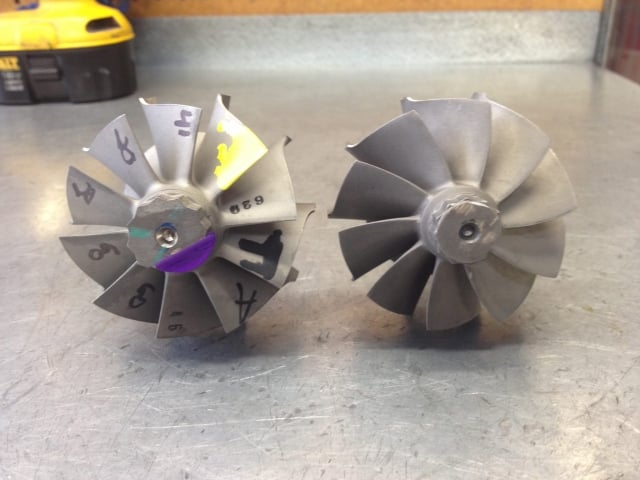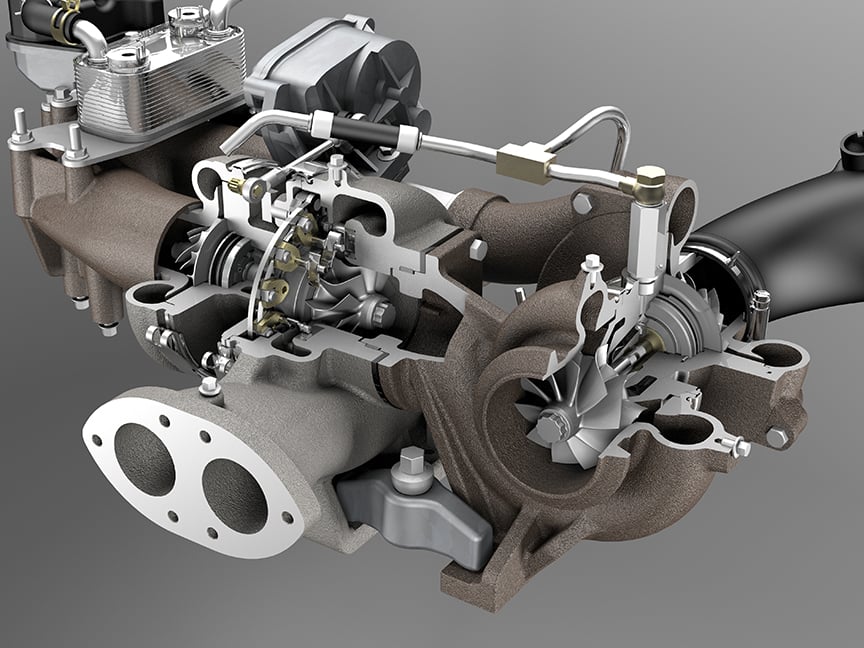http://www.dieselarmy.com/engine-tech/boosting-altitude-elevation-effects-turbochargers/Boosting With Altitude – How Elevation Affects TurbochargersBy Chad Westfall posted on Jul 8, 2014 in Power Adders, Tech Stories

Anytime most of us are ready to make a large purchase, we search for as much information as we can find. That usually means flipping through a lot of magazines, talking to friends, and searching the internet. So, when getting ready to make a large investment, such as a turbocharger, you want to know what is out there, what the best option is and where to get it for the best price.
The Issue
Photos courtesy of BorgWarner and High Tech Turbo.Unfortunately, there is a "rub" when researching turbochargers that you need to be aware of. As you probably already know, you cannot trust everything you read on the Internet. Outside of that, what works for one person may not always work for another. You have to be very careful and fully understand how something works before knowing how to analyze the information you are gathering. It isn't that people are necessarily trying to steer you wrong, but their environment may be different than yours, so their results may be different.

With a turbocharger, there are lots of different factors that play into how they work. There are hundreds of different combinations with all of the different options out there. There are different compressor cover sizes, compressor wheels, turbine wheels, turbine housings (wastegated and non-wastegated), ball bearing and journal bearings out there to name the major differences. Each combination will affect how the turbo works. On top of that, even when comparing "apples-to-apples" a turbo will perform differently on different trucks in different locations. Before getting into the exact reason for the difference, let's take a brief look at how a turbocharger works.
Overview of how a turbocharger works
Fresh air is sucked into the compressor and it is compressed as it is gets spun around the compressor cover until finally being sent out through the Charge Air Cooler (CAC) tubes. The compressing of the air, heats it up, which is the primary reason for needing an intercooler. Once the air is through the intercooler and into the cylinder, fuel is added and ignited. When the piston is almost at bottom dead center, the exhaust valve(s) open and the exhaust gasses are directed into the exhaust manifold(s) and then into the turbine housing. The hot exhaust gasses flow around the turbine housing (the A/R ratio for the turbine housing is the ratio of the area divided by the radius) and then are directed through the turbine wheel.
 Click here to read the article we did discussing the differences in the 70mm and 71mm turbine wheels.
Click here to read the article we did discussing the differences in the 70mm and 71mm turbine wheels.While this is an accurate and very common way of describing how a turbo works, it actually works in a slightly different order. The exhaust side of the equation starts first. Without the hot exhaust gasses being forced through the turbine wheel the compressor wheel would never create boost. The engine sucking air in alone won't spin the compressor wheel fast enough to create any boost.


 Turbochargers come in a variety of sizes and configurations. The top photo shows two turbochargers that are on engines. They get smaller than this and larger than this, but it is a good representative range of what you will see today in the non-industrial applications. The photo left and right are of two different turbine housings. Note the one on the right has a wastegated turbine housing.
Turbochargers come in a variety of sizes and configurations. The top photo shows two turbochargers that are on engines. They get smaller than this and larger than this, but it is a good representative range of what you will see today in the non-industrial applications. The photo left and right are of two different turbine housings. Note the one on the right has a wastegated turbine housing. This is a cutaway of a BorgWarner S500SX that is capable of supporting 900 to 1475 horsepower per charger.
This is a cutaway of a BorgWarner S500SX that is capable of supporting 900 to 1475 horsepower per charger.Exhaust driven
If you only look at the turbine wheel side of the equation, the wheel's speed is determined by the amount of thermal energy that can be transferred to mechanical (or rotational) energy. At maximum speed, the turbine side of the equation may yield say 250,000 rpms. But for anyone who has seen a turbo speed gauge you know that 99+% of chargers don't turn 250,000 rpms. So, if the turbine wheel is getting enough energy to turn that fast, what's slowing it down?
Well, that's where the other half of the equation comes into play. The turbine wheel is directly connected to the compressor wheel. As the turbine wheel is spinning pushing the exhaust out, the compressor wheel is sucking air in and compressing it. The compressor wheel is using a lot of the mechanical energy available to create the boost pressure. How much you may ask? Well, that's roughly the same energy being transferred into the boost air going into the intercooler. So, on a competition vehicle running 100 psi of boost, it is using up enough energy to heat up 1200 cfm of air to 500 degrees or more. That's a tremendous amount of energy being lost to the compressor side.
Altitude
Now, as the air density changes (let's say goes down, as with higher altitudes) the thermal energy needed to turn a specific RPM decreases, causing an increase in turbine shaft speed. According to Kurt Henderson, Engineer – Accelerated Innovation at BorgWarner, "A good rule of thumb is that the turbocharger speed will increase 1 to 2 percent every 1,000 ft of elevation increase."
(NOTE: Open next 2 images in a separate tab/window manually to view actual fullsize)

 Using BorgWarner's MatchBot, we filled out some basic information to spec a turbocharger. One is set for 500 ft above sea level and the other is 5,000 ft. Notice the huge difference in how the performance plots on the compressor mat (i.e. the red dots).
Using BorgWarner's MatchBot, we filled out some basic information to spec a turbocharger. One is set for 500 ft above sea level and the other is 5,000 ft. Notice the huge difference in how the performance plots on the compressor mat (i.e. the red dots).If you are someone who lives close to sea level and you are talking to a guy on a forum who lives in Denver, the same turbo isn't going to perform the same. Being 5,000 feet lower in elevation than the guy in Denver means the turbo will be spinning roughly 5 to 10 percent slower for the same power. That may or may not seem like a lot, but it may result in the same amount of boost coming in 200, 300 or even 400 rpm later. When cruising on the freeway (low RPMs) or taking off with a trailer hooked up, that's a huge difference! To get the performance he is getting, you may need to step down one or even two sizes just because of the altitude of your location.
 This is a cutaway of BorgWarner's sequential turbocharger setup that was used on the 6.4l Power Stroke.
This is a cutaway of BorgWarner's sequential turbocharger setup that was used on the 6.4l Power Stroke.In addition to altitude, when discussing who's getting what and how things perform, you must take into account temperature. As air density changes with altitude, it also changes with temperature. Anyone living in Phoenix, Arizona can testify to that. Their truck performs much better in the winter than during the summer. So, what is working for someone in North Dakota or Canada won't necessarily be the best option for someone in Arizona or another hot state.
The work around
Now, OEM's have gotten around this issue to a certain degree with variable vane turbochargers. By being able to adjust the RPM of the turbocharger, the OEM can bring in the boost where they deem appropriate. But, that's a whole different topic and article.
Just keep in mind; the internet is a great resource for information (thanks for supporting our digital magazine). But unlike your buddy down the street, the information you get, may need to be analyzed a little more to see how it applies to your particular situation.
 Even though you can get approximately the same size compressor wheel in these three different turbocharger (left is an EFR, center is an S300, and right is an S400), they all have different size compressor covers. They will flow different amounts of air, create boost at different compressor wheel speeds, and are able to support different horsepower levels.
Even though you can get approximately the same size compressor wheel in these three different turbocharger (left is an EFR, center is an S300, and right is an S400), they all have different size compressor covers. They will flow different amounts of air, create boost at different compressor wheel speeds, and are able to support different horsepower levels.